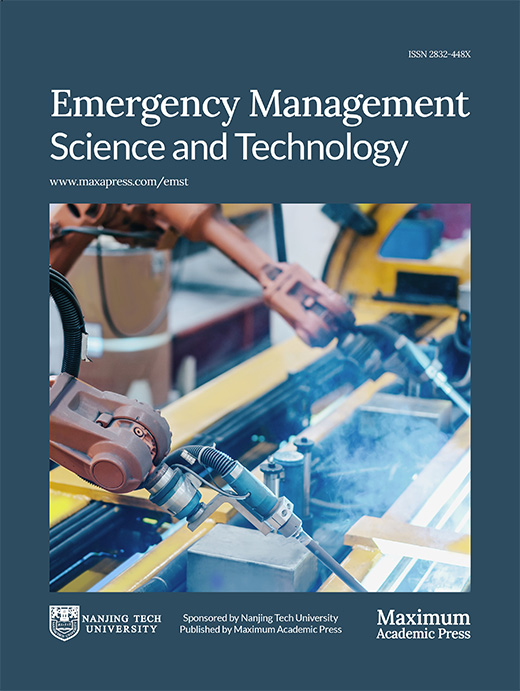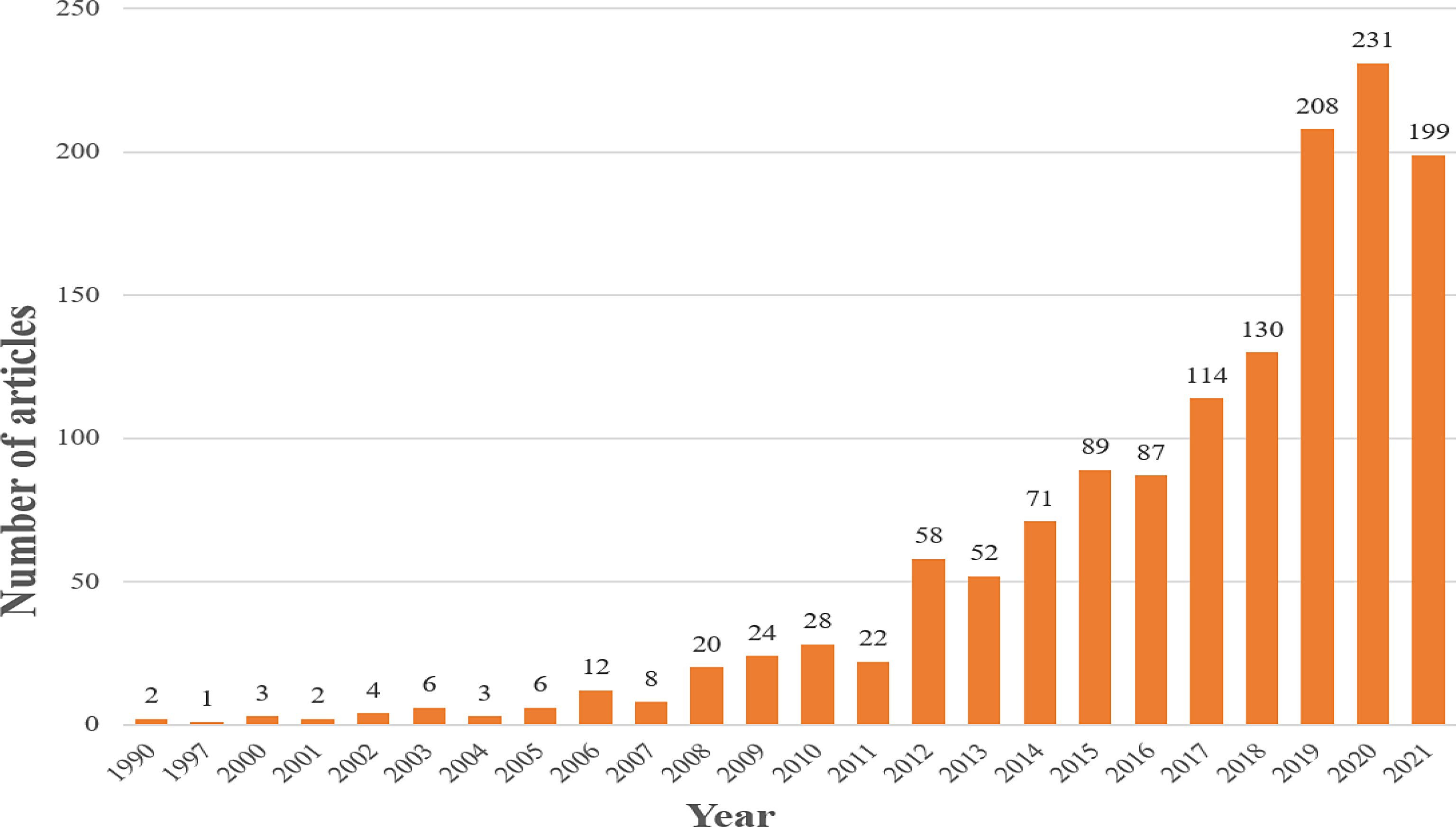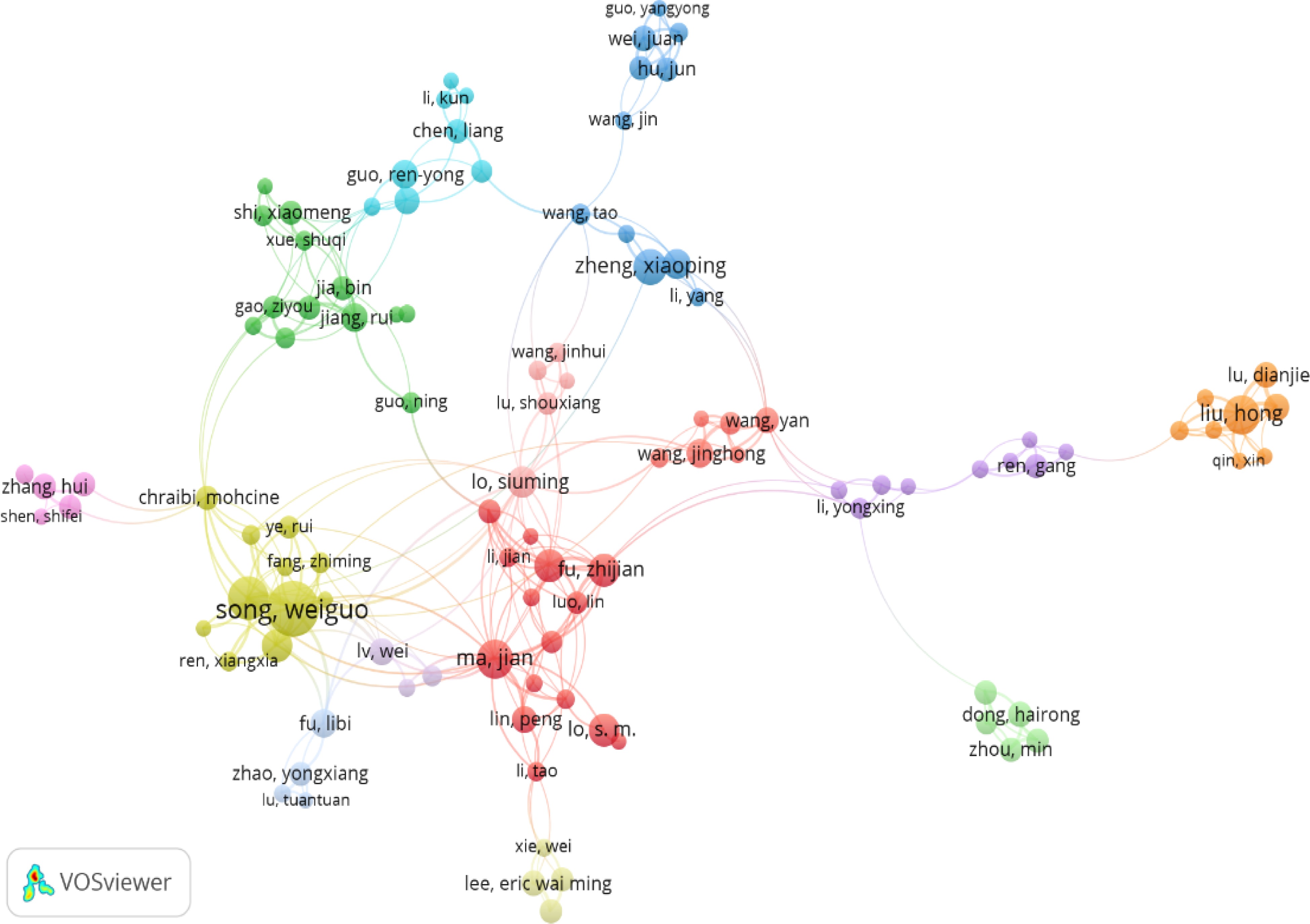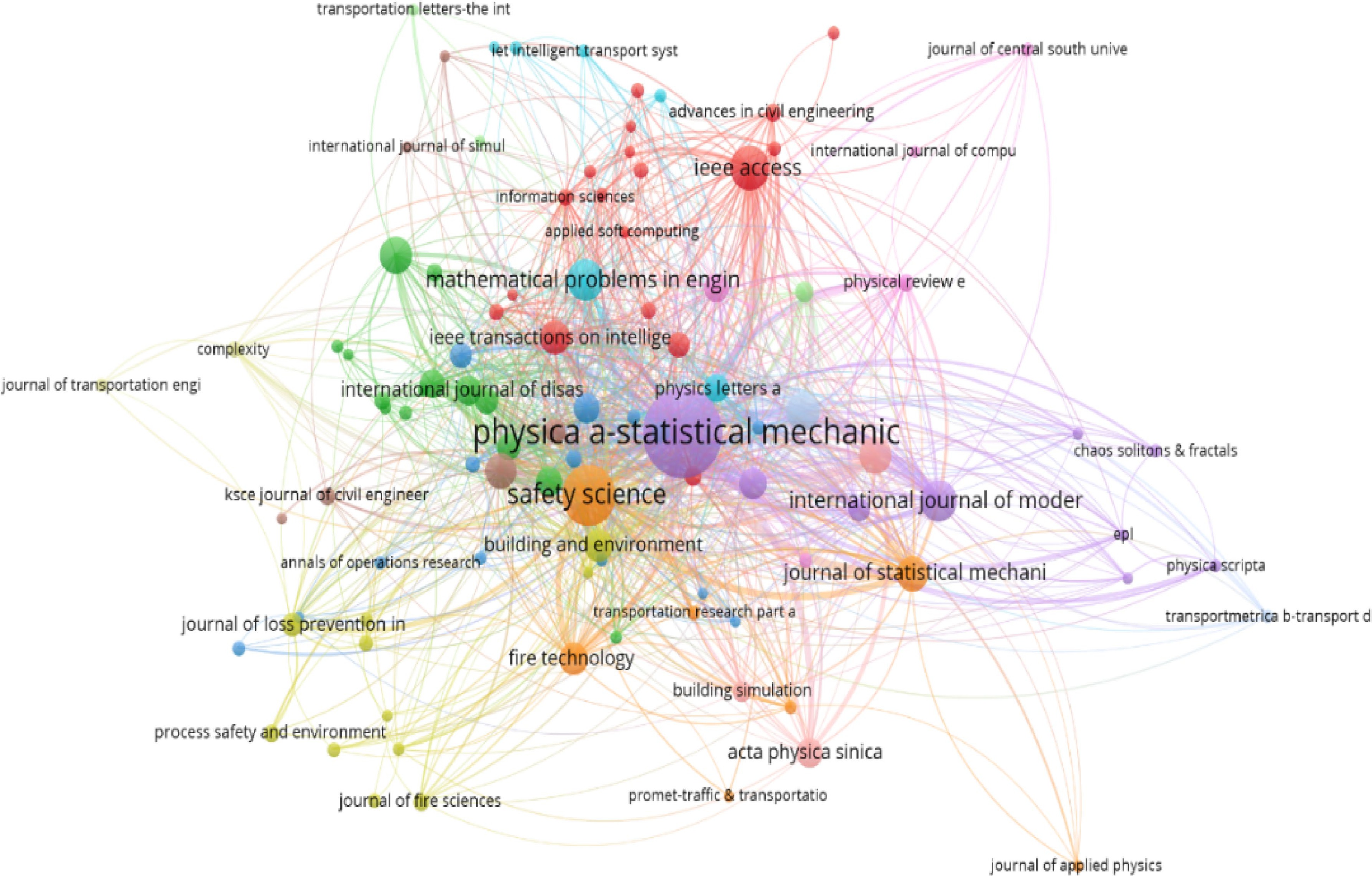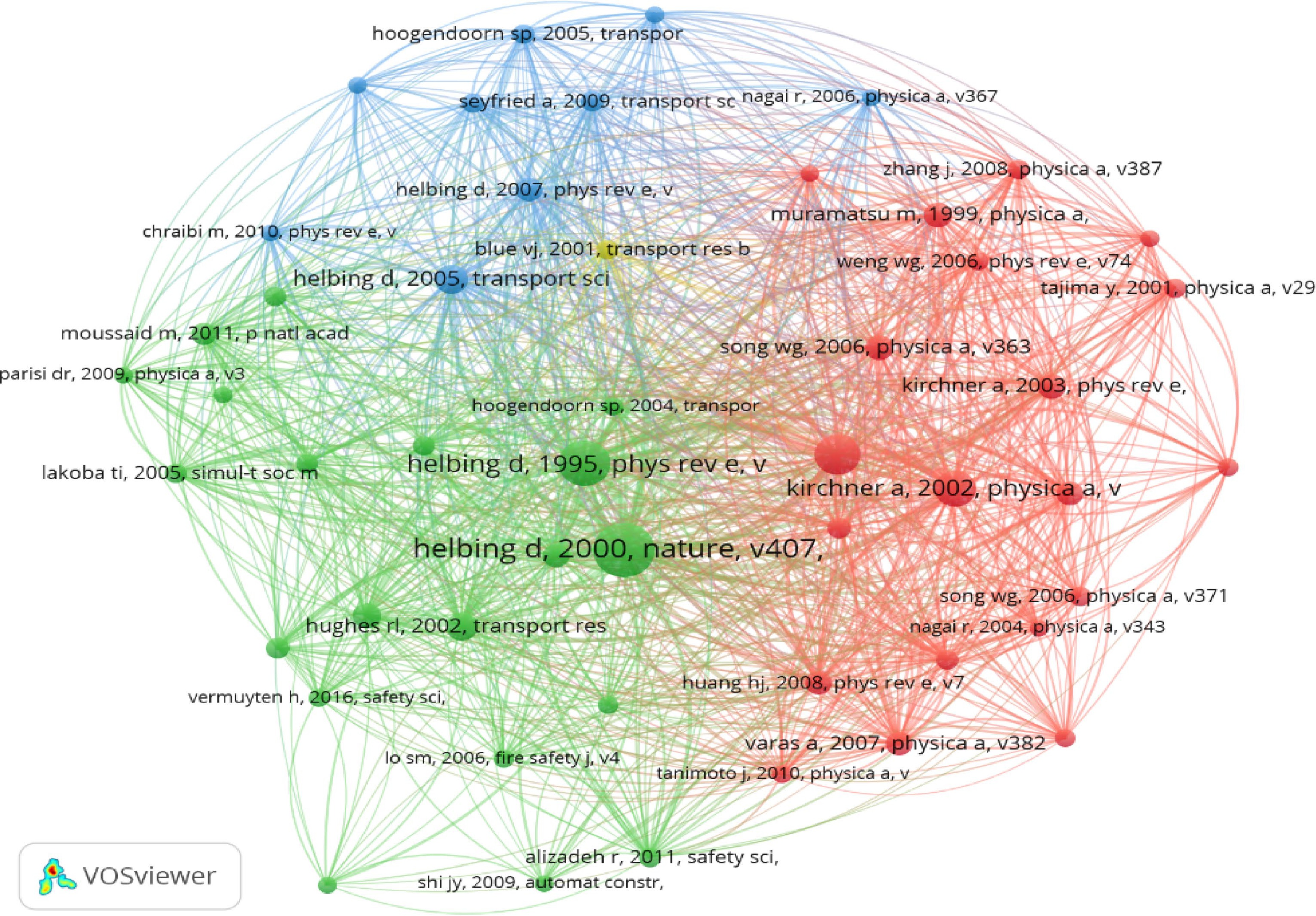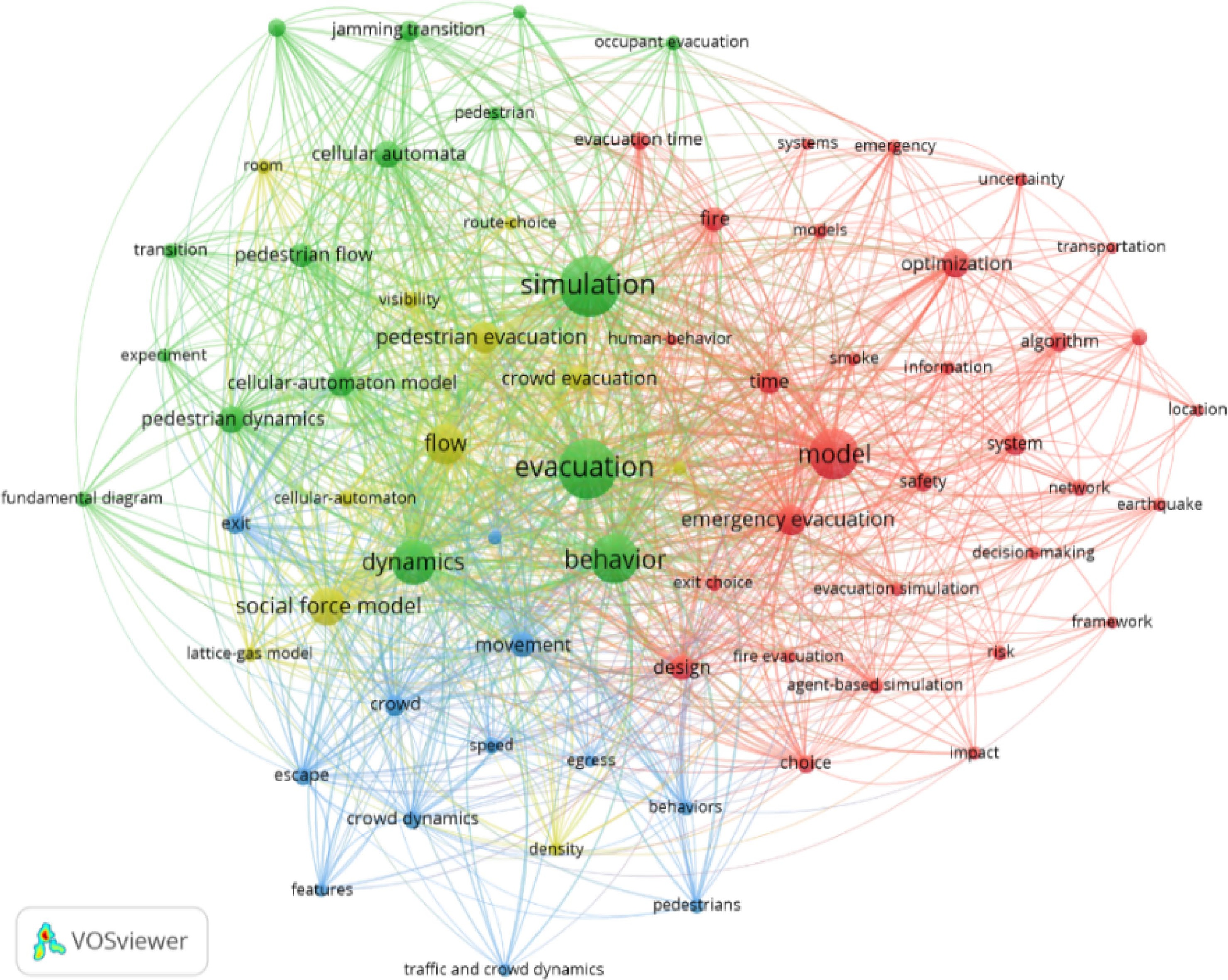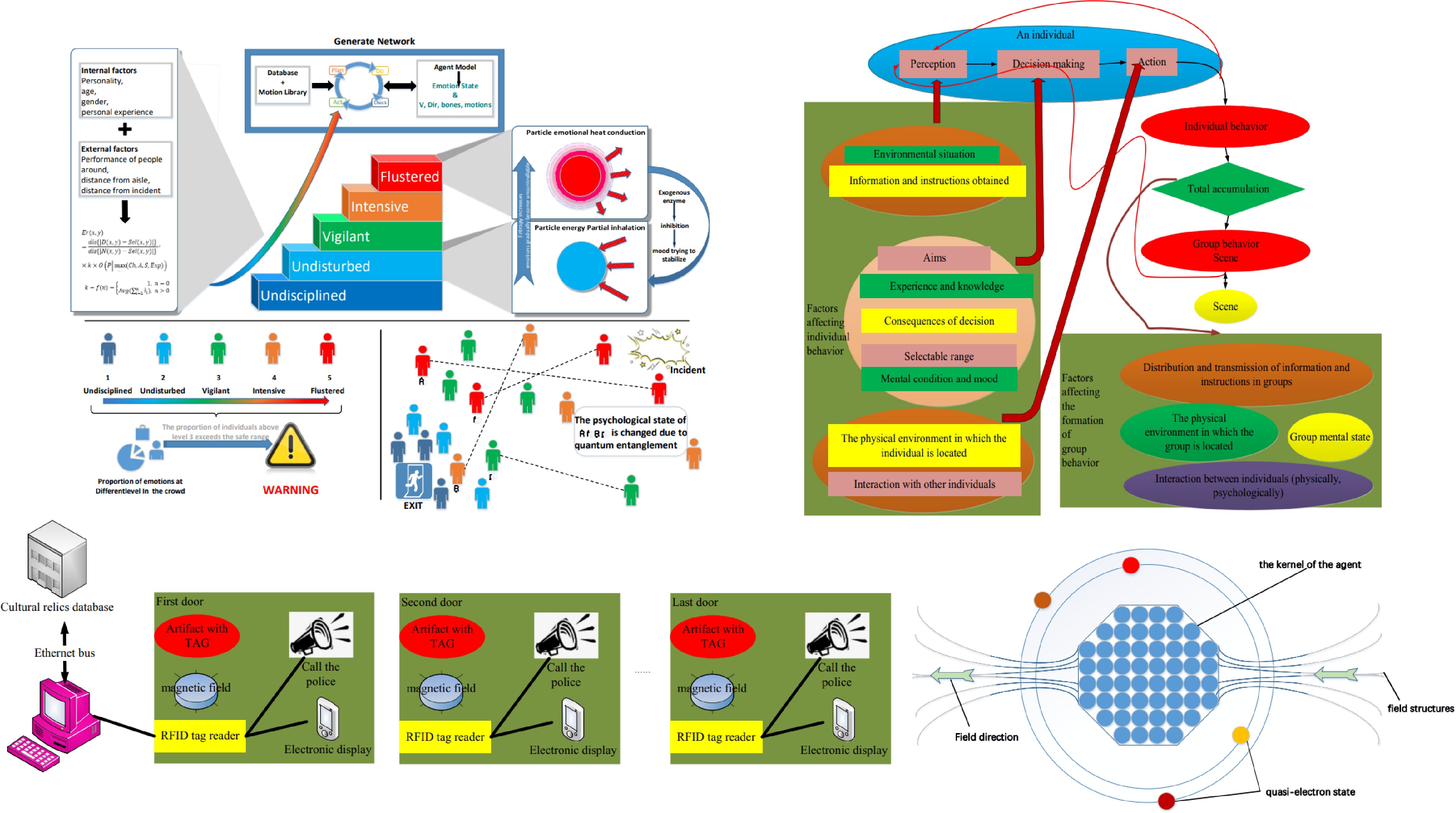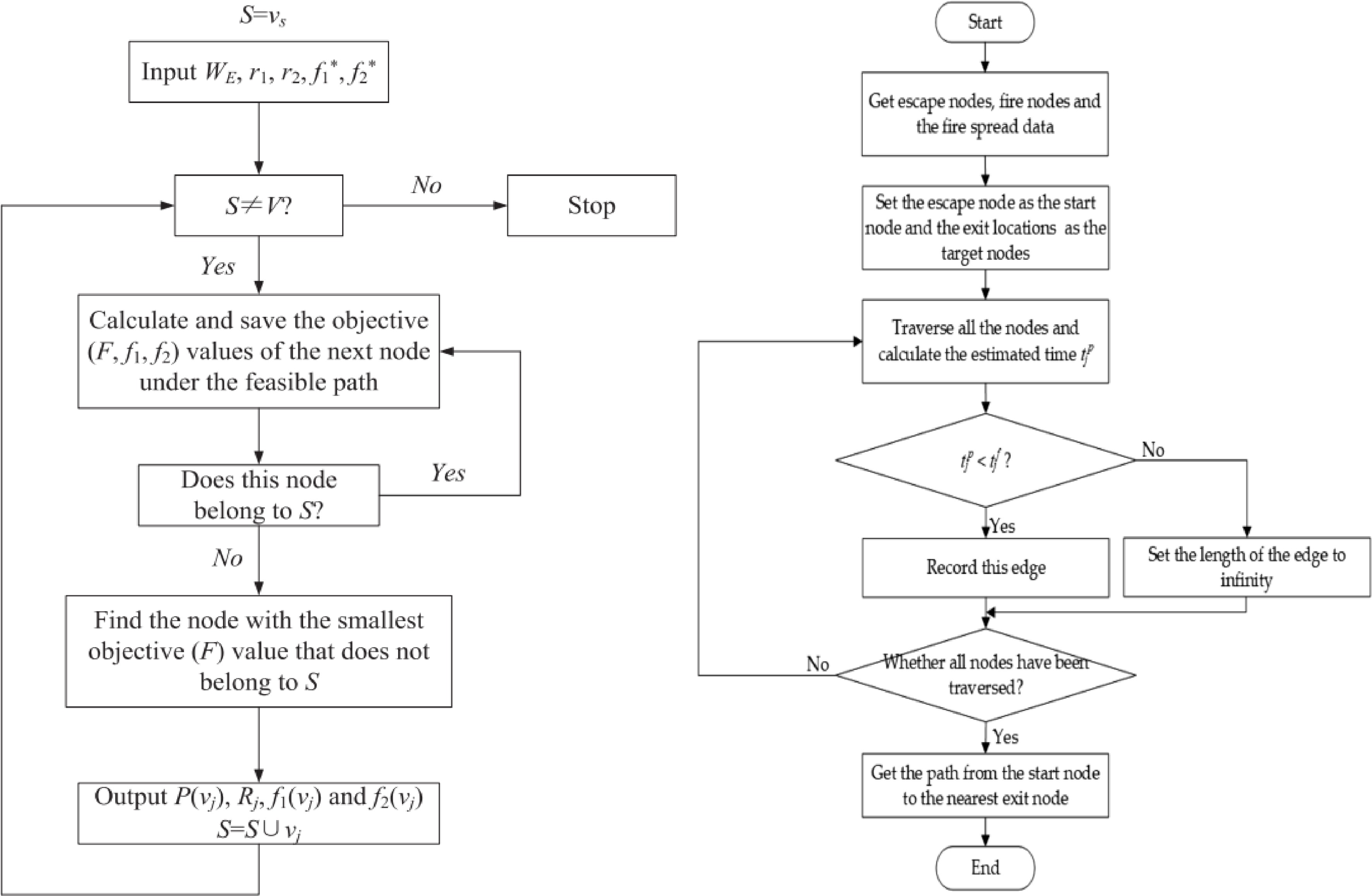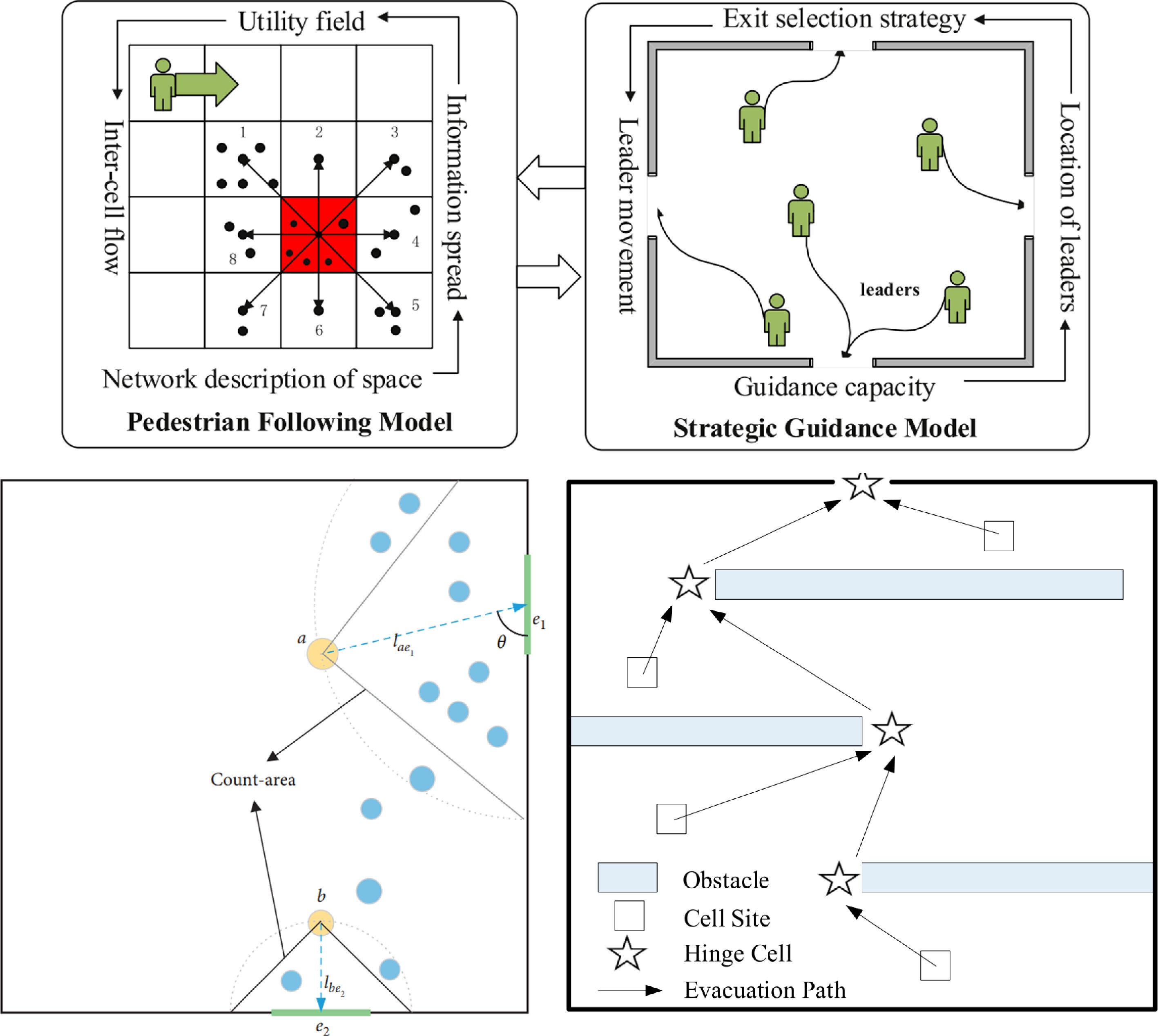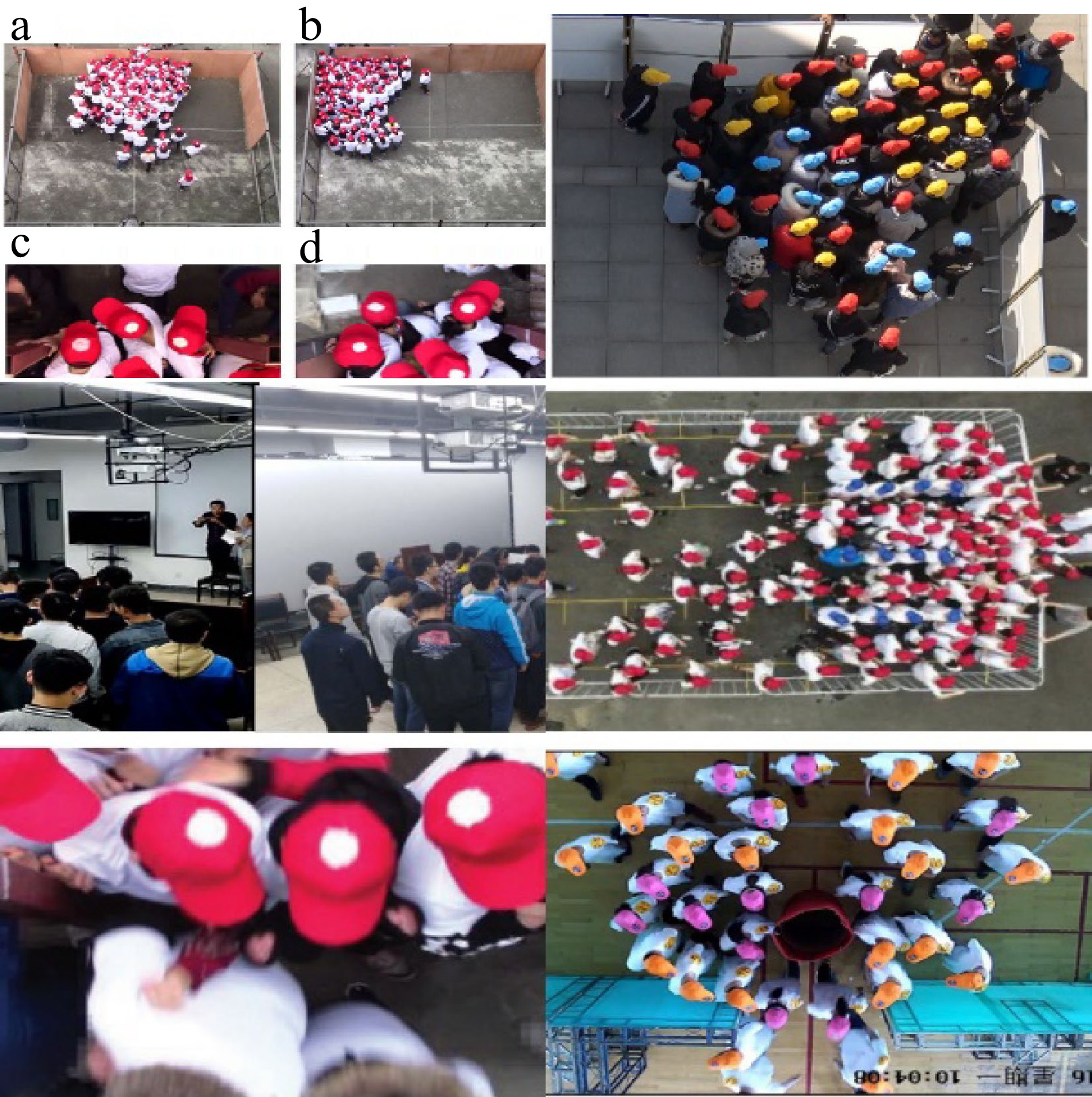-
According to the seventh census, China ranks first in the world with a population of over 1.4 billion. Due to the large population and the increase in the number of large commercial complex buildings in China, safety hazards have increased significantly. More serious accidents due to untimely evacuation also abound. According to incomplete statistics, there have been many casualties caused in crowd evacuation in China. Some of the causes of accidents and casualties are shown in Table 1.
Table 1. Summary of crowd evacuation casualty accidents in China.
Time Location Cause of accident Number of casualties February 5, 2004 Miyun County, Beijing A light show was held, a large trampling accident occurred due to crowding and trampling on the Rainbow Bridge and negligence of security personnel[1]. 37 people died and 37 people were injured December 31, 2014 The Bund of Shanghai A light show was held and someone overbalanced and there were too many people in the venue, resulting in multiple falls and subsequent crowding and trampling accidents[2]. 36 people died and 49 people were injured November 18, 2017 Beijing Daxing Xhongmen Town A householder refitted a building without authorization, the personnel after the fire did not get timely evacuation, causing a fire accident[3]. 19 people died and 8 people were injured February 25, 2017 Honggu Tan New District, Nanchang City, Jiangxi A hotel was privately closed for renovation without the approval of relevant authorities, resulting in blocked evacuation routes. People failed to evacuate in time after a fire broke out[4]. 10 people died and 13 people were injured April 2, 2017 Daguan Economic Development Zone,
Anqing CityA dust explosion occurred in a workshop. Due to non-compliance with the layout of the workshop and a certain exit was blocked by flammable materials, personnel did not escape in time[5]. 5 people died and 3
people were injuredMay 16, 2019 Changning District,
ShanghaiA plant collapse occurred. Due to the chaotic management of the plant site, serious casualties were ocurred[6]. 12 dead and 10 seriously injured March 7, 2020 Quanzhou, Fujian Province A major collapse occurred at a hotel where people were not evacuated in time due to the building's poor design[7]. 29 people died and 42 people were injured According to the survey, the study of bibliometrics around the world started in 1917. However, the first use of bibliometrics for literature research in China started in 1964[8]. Literature analysis using bibliometric methods can easily identify not only the hot spots and frontiers of research in the field of safety evacuation, but also the 'leaders' among scholars in the field[9]. At present, scholars in many fields use bibliometrics to evaluate the current status of research and the future development trends in their subject areas. Li & Zhao[10] carried out a study on environmental assessment. Sun & Grimes[11] explored the dynamic structure of Chinese emerging innovation research. In addition, literature reviews have been conducted using bibliometric methods in fields such as business economics[12−14], chemistry[15−17], computer science[18−20], and medical sciences[21−23]. However, in the field of safety evacuation, most scholars have favored traditional statistical methods of literature review to analyze the research frontiers in the field. For example, He et al.[24] reviewed the research progress of crowd psychological behavior mechanisms and crowd evacuation animation in the process of safety evacuation. Li et al.[25] reviewed the role and advantages of the cellular automata model in the study of personnel evacuation. Zhou et al.[26] reviewed the research on guidance methods and guidance techniques for crowd evacuation in emergency situations. Ding et al.[27] reviewed the recent literature on vertical evacuation of high-rise buildings. Zhu et al.[28] reviewed the research literature on the movement characteristics of pedestrians on stairs. Few scholars have used bibliometric methods to analyze and review the current state of research in the field of safety evacuation in China. Therefore, this paper adopts a combination of bibliometric and traditional literature review methods to search and count the research literature related to safety evacuation in the Web of Science core database for the 30 years from 1990 to 2021, and analyze the current research status and future development trend of this field. The results of the study can provide a reference for researchers and policy makers in the public safety field.
The structure of this paper is as follows: the second part of the paper describes the data sources and research methods; the third part describes the results of the literature analysis, including the year of publication and number of articles, subject distribution, author distribution, journal distribution, citation analysis, and keyword co-occurrence analysis; the fourth part describes the research hotspots of safety evacuation in China; and the fifth part provides the research conclusions of this paper.
-
The Web of Science database is the world's largest online database of academic journals[29]. To ensure the accuracy and credibility of the data, the literature used in this study was obtained from the Web of Science core database. The Web of Science core database of safety evacuation was searched on December 25, 2021. The search results of the Web of Science database differed slightly from date to date because the database is continuously updated[30]. Therefore, the data on the day of the search were taken as the research sample for this study. Using 'topic' as the search term, we entered 'evacuation' in the search box and searched the database for all literature containing this term in the title, abstract, or keyword list between 1990 and 2021. A total of 23,731 documents were searched. The screening of these articles is divided into three steps. First of all, this paper intends to study the research in the field of safety evacuation in China, so by selecting 'PEOPLES R CHINA', 'CHINA', 'TAIWAN' and 'HONG KONG' in the Countries/Regions column, the relevant literature on safety evacuation research in China was refined, and the remaining 3006 papers were screened out. Then filter out articles in irrelevant fields, such as 'medicine', 'geology', and 'economics' were excluded. Finally, after carefully screening and checking, a total of 1380 documents met the search requirements of this study. It should however be emphasized that the selection of articles related to 'safety evacuation' was carried out manually by the authors. Therefore, there may be a little oversight in the number of articles. The search records included title, author, abstract, keywords, year, journal, etc.
The types and numbers of documents retrieved are shown in Table 2. Most of the documents were Articles (1,352 articles, 97.97%), and both Meeting and Review Articles types were less than 20 documents. The total sum of the listed types of literature was 1,419, and the sum of the types of literature exceeded the number of retrieved literatures, so there were cases where the same literature belonged to multiple types.
Table 2. Literature category and quantity.
No. Document type Number of
literature/articleProportion (%) 1 Articles 1,352 97.97 2 Early Access 20 1.45 3 Meeting 19 1.38 4 Review Articles 16 1.16 5 Others 12 0.87 Research methods
-
Bibliometrics is the study of the literature system and bibliometric characteristics. It uses mathematical, statistical and other econometric research methods to quantitatively measure the status of research and the contributions made in a field[31,32]. Therefore, this paper intends to use bibliometric methods to study the current status of research and development trends of safety evacuation from quantitative and qualitative perspectives.
At present, the commonly used bibliometric analysis software mainly include VOSviewer and CiteSpace. VOSviewer has more advantages in large amounts of data analysis, displaying correlation strength and presenting the relationship between subject terms[33], while CiteSpace is more suitable for document analysis with small amounts of data, in this study we therefore chose VOSviewer for document analysis. VOSviewer software was used to analyze the authors, institutions, sources, and keywords of literature related to safety evacuation in China. VOSviewer software can be used to construct and view bibliometric maps, and providing the basic functions needed to visualize bibliometric networks in a relatively simple way[34]. The size of the circles in the VOSviewer network diagram indicates the level of importance. The larger the circle, the greater the importance. And the lines between the circles indicate the relatedness between research items. The closer the lines, the higher the degree of relatedness[35]. The VOSviewer software was used to visualize and analyze the literature, so as to identify the research hotspots, development trends and general characteristics of related literature in this field.
-
According to the search method introduced above, the research progress of the field in different time periods can be clearly viewed. The annual publication volume in the field of safety evacuation in China between 1990 and 2021 is shown in Fig. 1. As can be seen from Fig. 1, the overall trend of annual publications is on the rise, although the number of publications has decreased in some years. Before 2008, there were fewer related studies, and (with the exception of 2006), the number of publications in the remainder of the years did not exceed 10. 2017−2021 was the fastest growing five years in the field of safety evacuation in China, with the number of publications above 100 each year, indicating that the research enthusiasm in this field is increasing. The largest number of publications appears in 2020, with 231 publications, accounting for 16.74% of the total number of publications. It was followed by 2019, with 208 publications, accounting for 15.07% of the total number of publications. And 199 publications in 2021 rank in third place, accounting for 14.42% of the total number of publications.
According to the statistics of the number of publications, research related to safety evacuation in China until 2021 is divided into three phases. The first stage was from 1990 to 2007, which was named as the 'initiation stage'. The number of literature in this stage did not exceed 10 articles per year. Although the number of articles in this period was small, three of the top 10 cited papers were published in this period, and all of them were published in 2006 (see Table 3). According to the number of citations, the typical papers in this period include the following: Song et al.[36] established a 'multi-grid model' based on the social force model to study the interaction between two factors affecting evacuation; Lo et al.[37] explored the method of finding escape exits during emergency evacuation; Song et al.[38] explored the reasons for the complex behavior of people during evacuation; Yang et al.[39] developed a cellular automata model to simulate the effect of kinship behavior on evacuation efficiency during evacuation; Lo et al.[40] proposed a spatial grid evacuation model (SGEM) to simulate the pedestrian evacuation process.
Table 3. The top 10 cited literature of Chinese scholars in safety evacuation from 1990 to 2021.
Rank Title of article First author Source Citation
ratesPublished
yearAddress 1 Modeling crowd evacuation of a
building based on seven methodological approachesZheng Xiaoping Building And Environment 349 2009 Beijing Univ Chem Technol 2 Simulation of evacuation processes
using a multi–grid model for
pedestrian dynamicsSong Weiguo Physica A Statistical Mechanics And Its Applications 208 2006 Univ Sci & Technol China 3 Static floor field and exit choice for pedestrian evacuation in rooms with internal obstacles and multiple exits Huang Haijun Physical Review E 198 2008 Beijing Univ Aeronaut & Astronaut 4 Agent–based modelling and simulation
of urban evacuation: relative
effectiveness of simultaneous and
staged evacuation strategiesChen Xuwei Journal of The Operational Research Society 183 2008 SW Texas State Univ 5 Route choice in pedestrian evacuation under conditions of good and zero visibility: Experimental and simulation results Guo Renyong Transportation Research Part B–Methodological 178 2012 Inner Mongolia Univ 6 A game theory based exit selection
model for evacuationLo Siuming Fire Safety Journal 164 2006 City Univ Hong Kong 7 Agent–based evacuation model of large public buildings under fire conditions Shi Jianyong Automation in Construction 162 2009 Shanghai Jiao Tong Univ 8 Evacuation behaviors at exit in CA
model with force essentials: A
comparison with social force modelSong Weiguo Physica A Statistical Mechanics And Its Applications 151 2006 Univ Sci & Technol China 9 A social force evacuation model with
the leadership effectHou Lei Physica A Statistical Mechanics And Its Applications 145 2014 Shanghai Univ Sci 10 A dynamic evacuation network optimization problem with lane reversal and crossing elimination strategies Xie Chi Transportation Research Part B–Logistics And Transportation Review 137 2010 Univ Texas Austin The second phase was from 2008 to 2016, which is named as the 'initial development phase', and the number of literature in this phase is 20-100 per year. This period has the highest number of highly cited literature publications (see Table 3). Based on the number of citations, some typical papers in this period include the following: Zheng et al.[41] analyzed the advantages and disadvantages of seven crowd evacuation models including the cellular automata model; Huang & Guo[42] designed a modified floor field model to simulate pedestrian evacuation in rooms with internal obstacles and multiple exits; Guo et al.[43] studied the pedestrian evacuation path selection problem under good and zero visibility conditions; Shi et al.[44] proposed a system simulation model to simulate the evacuation process of people in a fire situation; Hou et al.[45] investigated the effect of the number and location of leaders on the evacuation efficiency.
The third phase is from 2017 to 2021, which is named as 'high speed development phase', and the number of papers in this phase is more than 100 per year. In this period, a large number of scholars in China have joined the research field of safety evacuation, so the number of literature exceeds 200 in 2019 and 2020. Among the literature with high numbers of citations, the more typical ones include: Liu et al.[46] proposes a novel emergency evacuation path planning method combining the Extended Social Force Model (ESFM) and the Improved Artificial Bee Colony (IABC) algorithm, this paper has been cited 143 times. Liu et al.[47] established a crowd evacuation simulation approach that is based on navigation knowledge and two-layer control mechanism; Lu et al.[48] studied the influence of group for on personnel evacuation; Zhao et al.[49] study the impact of different obstacle shapes and distance from exit locations on evacuation efficiency; Chen et al.[50] study the collision avoidance behavior of pedestrians in two-exit classrooms during evacuation through a cellular automata model; Liu et al.[51] proposes a video data-driven social force model for simulating crowd evacuation.
Discipline distribution of literature
-
The discipline distribution of the research literature is to understand the distribution of different disciplines in the field of safety evacuation research and to explore the leading disciplines in this field. By looking at the 'Analyze Results' of the Web of Science core database, we can see that there are 56 categories of disciplines involved in this field, among which 15 categories contain only one article and six categories contain only two articles.
In this study, the number of relevant articles in each discipline were counted, and the hot disciplines in the field were investigated according to the ranking of the literature volume. The top 10 discipline categories in terms of literature volume and the number of publications are shown in Table 4. The sum of the volume of each discipline category in the table exceeds the sum of the retrieved literature, indicating that the disciplines are not independent of each other, and a piece of literature may be involved in more than one discipline. From Table 4, we can see that the top 10 disciplines in terms of volume are Engineering, Physics, Computer Science, Transportation, Operations Research Management Science, Mathematics, Construction Building Technology, Science Technology Other Topics, Environmental Sciences Ecology, and Materials Science. The leading discipline in this field is Engineering, with 542 articles, accounting for 39.275% of the total number of articles. This is followed by Physics (349 articles, 25.290%). The third is Computer Science (303 articles, 21.957%). Literature review shows that evacuation studies are mostly concentrated in buildings, such as super high-rise buildings, underground multi-story buildings, etc. Moreover, the research on the dynamics of crowd evacuation behavior is usually biased toward physical modeling, so Engineering and Physics disciplines are the two disciplines with the largest number of articles. Computer Science is also on the list, indicating that computer technology is increasingly being used in the study of safety evacuation, and intelligent evacuation tools are being explored and gradually applied.
Table 4. Statistics on the distribution of the top 10 disciplines in the literature related to the field of safety evacuation in China during the period 1990−2021.
Rank Subject category Number of
publicationsPercentage of total
publications (%)1 Engineering 542 39.275 2 Physics 349 25.290 3 Computer Science 303 21.957 4 Transportation 143 10.362 5 Operations Research Management Science 112 8.116 6 Mathematics 103 7.464 7 Construction Building Technology 97 7.029 8 Science Techology Other Topics 83 6.014 9 Environmental Sciences Ecology 80 5.797 10 Materials Science 73 5.290 Distribution of authors in the literature
-
Finding the distribution of authors of the literature helps to understand the important contributions of the authors in the field. The retrieved literature was written by more than 200 different authors, and the top 10 authors of the published literature were counted, and the statistical results are shown in Fig. 2. The authors of the literature were clustered and analyzed by VOSviewer to obtain a collaborative network view of the authors related to safety evacuation, as shown in Fig. 3, where the colors in the figure represent collaborative clusters (groups), which can identify the highly productive authors in the field, as well as the collaborative relationships among the authors. It is worth noting that the literature search results in the Web of Science database cannot distinguish between authors with the same name, so the author searched the literature manually in order to filter the authors with the same name and the same institution as the same author.
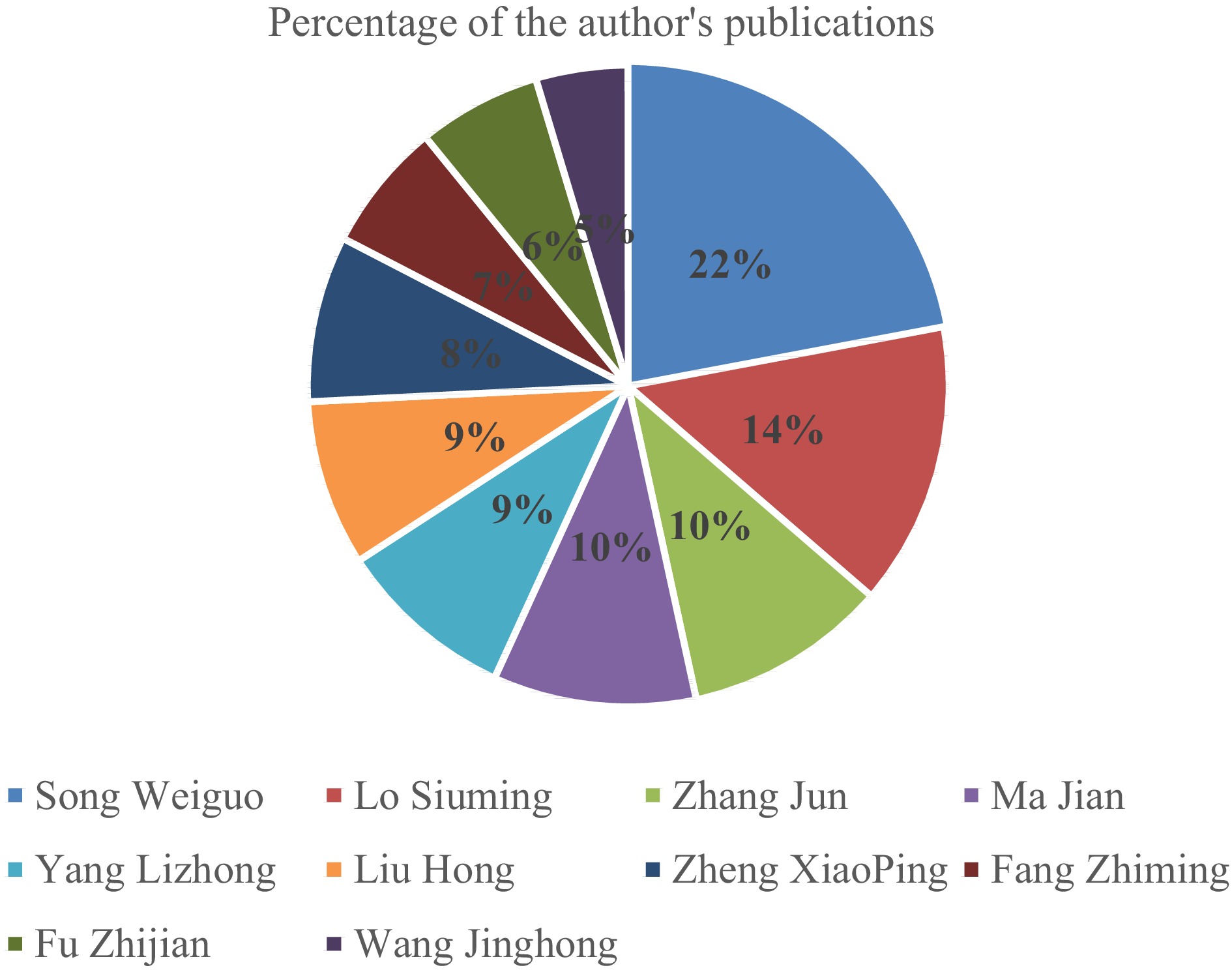
Figure 2.
Statistics of the top 10 authors in the number of publications in the field of safety evacuation Web of Science from 1990 to 2021.
The author with the highest number of publications is Song Weiguo (Univ Sci & Technol China, 22%), who has published work in 27 journals. The next highest author is Lo Siuming (City Univ Hong Kong, 14%), and it is noteworthy that the two scholars have co-authored more than 10 publications. In addition, many of the papers are co-authored by multiple authors. For example, Song Weiguo & Zhang Jun co-authored in 2021: Where luggage-related facilities should be placed along passageways in traffic hubs: right, left, or in the middle?[52]; Yang Lizhong & Fu Zhijian co-authored in 2018: Update schemes of multi-velocity floor field cellular automatization for pedestrian dynamics[31]; Ma Jian & Lo Siuming co-authored: Pedestrian ascent and descent fundamental diagram in 2017[53]. Figure 3 also shows that the main research scholar in this field is Song Weiguo. According to the color division of the network diagram, the authors can be roughly divided into 11 groups, indicating that scholars studying safety evacuation in China are closely connected with each other, and mostly choose to conduct research through teamwork.
In addition, most of the scholars in the field of safety evacuation conduct their research within universities, and therefore most of the institutions to which the published related articles belong are universities. Further analysis of the research institutions of the safety evacuation-related literature in China using VOSviewer software helps to understand the leading institutions in the field. Statistics on the number of articles issued by each institution are shown in Table 5 (taking the top 10). There are three institutions with more than 100 articles, namely University of Science and Technology of China (149 articles), Beijing Jiaotong University (109 articles), and Tsinghua University (107 articles). So these three institutions are leading the way in this field.
Table 5. Statistics on the number of articles issued by each institution.
Rank Literature research institution Number of publications 1 University of Science and Technology of China 149 2 Beijing Jiaotong University 109 3 Tsinghua University 107 4 City University of Hong Kong 78 5 Southwest Jiaotong University 67 6 Wuhan University of Technology 50 7 Tongji University 48 8 Chinese Academy of Sciences 41 9 Southeast University 38 10 Beihang University 38 Journal distribution
-
The search yielded 1,380 papers from about 270 journals, of which 130 journals published only one paper in the field of safety evacuation and 39 journals published two related papers. The core journals in this field can be derived through law of Bradford, and the formula for calculating the number of Bradford core journals was proposed by the Belgian scholar L. Egghe[51] , that is, r0 = 2ln(eE × Y), where E is a constant value of 0.5772, and Y denotes the number of papers in the journals with the largest amount of literature, which is 172 in this paper, and is brought in to obtain the number of core journals of about 11 papers. VOSviewer software was used to draw the journal co-occurrence network diagram, as shown in Fig. 4. The information of core journals is shown in Table 6. The analysis shows that the journal Physica A- Statistical Mechanics And Its Applications has the highest number of publications with 172 articles, accounting for 12.5% of the total literature, and is the most prolific journal in this field. The next most prolific journal is Safety Science (80 articles, 5.8%). Third in the list is the IEEE Access journal (42 articles, 3.0%). The complex of connecting lines between the circles in the Fig. 4 indicates that the journals are closely linked and are citing each other.
Table 6. Information of core journals in the field of safety evacuation.
Rank Journal name Number of articles Percentage
of total
publications (%)Impact factor* 1 Physica A Statistical Mechanics and Its Applications 172 12.464% 3.295 2 Safety Science 80 5.797% 5.16 3 IEEE Access 42 3.043% 4.983 4 Mathematical Problems in Engineering 37 2.681% 1.125 5 International Journal of Modern Physics C 36 2.609% 1.453 6 Simulation Modelling Practice and Theory 31 2.246% 3.336 7 Sustainability 30 2.174% 2.966 8 Chinese Physics B 29 2.101% 1.265 9 Journal of Statistical Mechanics Theory and Experiment 28 2.029% 1.425 10 Fire Safety Journal 27 1.957% 2.802 11 IEEE Transactions on Intelligent Transportation Systems 24 1.739% 8.632 * Impact factor taken from 2021 Literature citation analysis
-
The number of citations reflects the recognition and influence of the literature in its field, as well as the current research hotspots and trends in the field. Among the 1,380 documents retrieved, 22 documents were cited more than 100 times and two documents were cited more than 200 times. Table 3 summarizes the top 10 cited literature in the field of safety evacuation during the period 1990–2021. From Table 3, it can be seen that most of the top 10 cited articles are from before 2010. And combined with the analysis of the number of publications above, it can be seen that the number of citations is higher before 2010 although the number of publications is lower. The most cited literature is the review paper by Zheng et al. Modeling crowd evacuation of a building based on seven methodological approaches published in Building And Environment in 2009[41]. The article describes seven approaches to studying crowd evacuation in buildings and discusses the advantages and disadvantages of each. Later scholars cited this literature to explore: a modified approach to pedestrian dynamics that allows for crowd dynamics guidance[54]; a novel social force model describing pedestrian movement on stairs and evacuation dynamics[55]; the effect of building environment and evacuation behavior on evacuation time[56].
The second most cited is: Simulation of evacuation processes using a multi–grid model for pedestrian dynamics published in 2006 in the journal Physica A - Statistical Mechanics And Its Applications, written by Song et al.[36]. This article analyzed the rules of interactions among pedestrians or pedestrians and constructions and the influences of interaction forces and drift on evacuation time. Later scholars carried out research on the relationship between microscopic features of pedestrian dynamics based on this paper[57], and novel meta-automata models considering heterogeneous behavior of pedestrians[58].
The third is Static floor field and exit choice for pedestrian evacuation in rooms with internal obstacles and multiple exits[42], published in Journal of Physical Review E. In this article, a modified floor field model is proposed to simulate pedestrian evacuation in rooms with internal obstacles and multiple exits, and employing a logit-based discrete choice principle to govern the exit selection. Later scholars cited this literature to study: pedestrian path selection behavior during evacuation in indoor areas with obstacles[59]; pedestrian evacuation dynamics affected by fire spread[60].
It is worth noting that among the top 10 cited papers, two papers are from Song and three papers are from the journal Physica A Statistical Mechanics And Its Applications.
In addition, co-citation analysis of the relevant literature is considered in this paper. Based on the Minimum number of citations of a cited reference = 50, 50 literature records satisfying the threshold value are selected from 24,818 references to generate a visual network mapping of the co-citation analysis of the literature (as shown in Fig. 5). In the co-citation analysis network of the literature, the size of the nodes reflects the total frequency of citations of a particular literature, i.e., the higher the number of citations, the larger the nodes[61]. From Fig. 5, the top two cited articles are all from the authors Helbing et al[62], who wrote Simulating dynamical features of escape panic in 2000 and Social force model for papers in 1995. The third is the paper Simulation of pedestrian dynamics using a two-dimensional cellular automation by Burstedde et al.[63].
Keyword analysis
-
Keywords are conceptual words extracted by authors from the text to describe their research in a concise way. The analysis of keywords can help with understanding the research hotspots and future development trends in related fields, which is the core content of this study, and it is also one of the important ways to effectively search literature. The keyword analysis method in Callon et al. From translations to problematic networks: An introduction to co-word analysis[64] has been widely cited. In this paper, VOSviewer software was used to conduct keyword analysis on 1,380 retrieved articles and draw the network diagram of literature keyword co-occurrence, as shown in Fig. 6. In the total of 4,261 keywords, those with more than 20 occurrences were recorded, and a total of 70 keywords met the requirements. The connecting lines between the circles in Fig. 6 indicate the relevance of the keywords, indicating that the keywords are closely connected with each other. The keywords in Fig. 6 are roughly divided into four groups by color, and the keywords in the same group usually have closer relationships[65]. Words such as simulation, behavior, cellular automata are a cluster, such as shown by Dang et al.[66] who explored a virtual reality large-scale crowd evacuation chain navigation grid based on meta-cellular automata. Model, time, emergency evacuation are a cluster, e.g., Wang et al.[67] explored a subway station emergency evacuation model considering personality traits. Flow, social force mode, pedestrians are a cluster, such as Wang & Cao[68] studied a simulation model of pedestrian evacuation strategy under limited visibility. Movement, crowd, speed are a cluster, e.g., Huang et al.[69] studied an experiment on the evacuation behavior of passengers in high-rise deck buses.
The keywords with high frequency are simulation, evacuation, model, behavior, dynamics, flow, social force model, pedestrian evacuation, emergency evacuation, and pedestrian dynamics. This indicates that the current research in the field of safety evacuation in China is mainly focused on these hot spots. The term 'simulation' appears most frequently, which indicates that model simulation is more widely studied in the field of safety evacuation in China. In addition, the study of pedestrian dynamics is also more common.
The keywords in different years also have obvious differences. According to the analysis of the year of publication and the number of articles above, keyword co-occurrence analysis was conducted in three phases using VOSviewer software, and the keyword co-occurrence network diagram is shown in Fig. 7. From Fig. 7, the hot keywords in the first stage (1990–2007) are jamming transition, cellular automata; simulation, computer, and evacuation model. The hot keywords in the second stage (2008–2016) are behavior, dynamics, flow, model, and cellular automata. And the hot keywords in the third phase (2017–2021) are simulation, flow, exit choice, route choice, and fire. The hot keywords in the different stages are shown in Table 7.
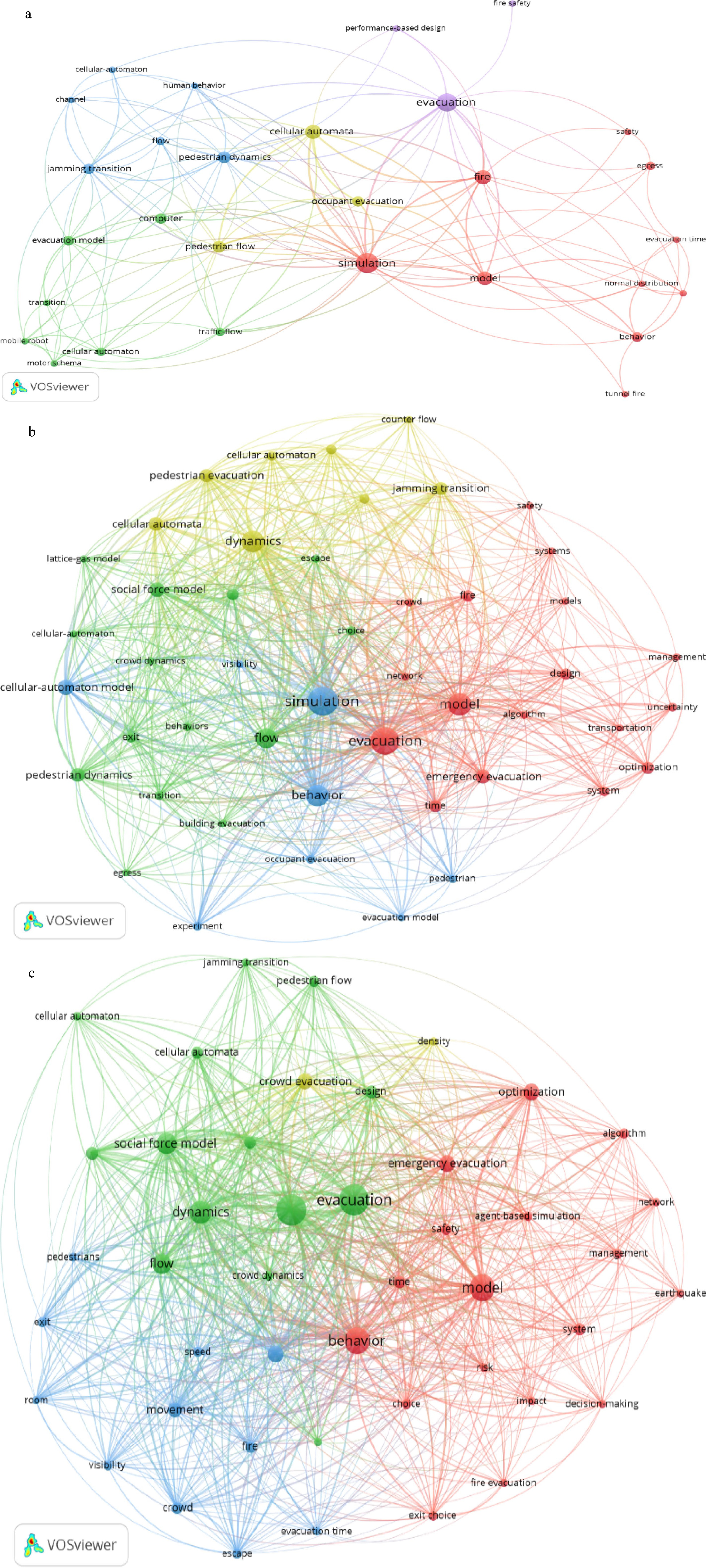
Figure 7.
Co-occurrence network of literature keywords at each stage: (a) the first stage; (b) the second stage; (c) the third stage.
Table 7. Hot keywords in different stages.
No. 1990–2007 2008–2016 2017–2021 1990–2021 1 simulation simulation simulation simulation 2 fire model behavior evacuation 3 model behavior model model 4 computer dynamics evacuation behavior 5 jamming transition flow dynamics dynamics 6 pedestrian dynamics evacuation flow flow 7 cellular automata cellular-automata mode social force model social force model 8 pedestrian flow social force model pedestrian evacuation pedestrian evacuation 9 evacuation pedestrian dynamics optimization emergency evacuation 10 occupant evacuation jamming transition emergency evacuation pedestrian dynamics When comparing the hot keywords in the three stages, it is found that the hot keywords in each stage have not changed much. The simulation study has been the hot method of safety evacuation research in China, steadily appearing in the first place. Compared with the first stage, the study of pedestrian behavior in the second and third stages gradually becomes a hot spot. In Fig. 7, it can be seen that in addition to the hot keywords, the research on the selection of paths and exits has also increased significantly in the third stage, where the research combined with optimization, i.e., the optimal evacuation path selection under fire situations, is also increasing. It can be seen that with the development of economy and technology in China, the number of high-rise buildings and large integrated commercial buildings is gradually increasing, and the resulting safety accidents are also increasing, so people's attention to the safe evacuation after fire is also increasing, and the research hotspots are gradually shifting to the selection of optimal escape paths.
In the next few years, with the increase of large underground commercial complexes in China, the research of safety evacuation may shift from above-ground buildings to underground buildings. The evacuation of people in underground shopping malls may become a new hot issue. In addition, studies on the safe evacuation of people often requires the organization of large crowds for experiments, whereas the experimental costs are large and there are more uncertainties during experiments. Therefore, in the field of evacuation research, the most used method is computer simulation. With the rapid development of intelligent technology in China in recent years, intelligent evacuation tools are also being gradually explored and applied. In summary, the trends in the field of evacuation of people are mainly focused on the 'modification of evacuation models' and the 'evacuation behavior of pedestrians'. Among them, the combination with 'fire', 'optimization' and 'emergency management' is also becoming a research trend.
-
According to the keyword analysis, it can be seen that the keywords 'simulation' and 'model' appear more frequently, so the research of crowd evacuation through model simulation has been the research hotspot in the field of safety evacuation in China. In the second and third stages, the keyword 'behavior' appears more frequently, so the study of pedestrian behavior gradually becomes a hot spot. In view of this research hotspot, the following analysis will focus on the research on crowd behavior of large-scale group evacuation. In the third stage, there is a significant increase in the research on crowd path and exit selection behavior, in which the research combined with 'optimization', i.e., the optimal evacuation path selection of crowds under fire situations, is also significantly increased. In response to this research hotspot, the following part will summarize the research on path planning during crowd evacuation and the optimization of exit bottlenecks. In summary, the following research hotspots will be specifically reviewed related to three aspects: first, research on large-scale mass crowd evacuation; second, research on path planning during crowd evacuation; and third, research on optimal design of evacuation exits.
Mass crowd evacuation
-
The behavior of crowds in emergency situations is complex and stochastic, so scholars have paid particular attention to the uncertainty in the evacuation process of pedestrians. The specific description of the research methods and the findings of the study can be found in Table 8. In the study of large-scale group evacuation behavior, Wang et al. proposed a method to qualitatively simulate panic propagation in mass crowd evacuation, and established a simulation model of panic behavior based on system dynamics[70], to study the uncertainties affecting mass evacuation from the perspectives of efficiency and risk[71]. Cui et al.[72] analyzed the behavioral characteristics of large event audience groups and proposed a large-scale group evacuation method for large events. Zhan et al.[73] studied the path selection model for large-scale typhoon-resistant crowd evacuation in an uncertain environment under typhoon disaster. Ma et al.[74] proposed a large crowd evacuation method based on RFID (radio frequency identification) mutation theory for large crowds in cultural museums. Mei et al.[75] proposed a simulation method using the entangled emotional model (EEM) to deal with the gathering phenomenon and group collision problem during large-scale crowd evacuation.
Table 8. Specific analysis of the cited literature on mass crowd evacuation.
Author, year Panic Model Algorithm Measured variables Main research contents Wang, 2012 √ √ The numbers evacuated; correct rate of evacuation direction; speed; human traffic The model reproduces a well-known phenomenon in crowd evacuation, namely fast is slow, and confirms that the severity of disaster exponentially positively correlates with the panic spread, and the effectiveness of rescue guidance is influenced by the leading emotion in the crowds as a whole. Wang, 2013 √ √ Density The effectiveness of rescue strategies was found to be strongly related to crowd density. The higher the crowd density, the larger the minimum number of passageways for effective evacuation will be. Cui, 2016 √ This paper proposes an audience behavior rehearsal and simulation system that can be applied to the real activity. The system can realize the behavior planning of the audience in the early period of large-scale organization and modularize the organization flow. Zhan, 2019 √ √ Time A route selection model for anti-typhoon crowd evacuation vehicles was built. The vehicle road impedance coefficient was used to embody the abilities of different vehicles in executing evacuation tasks. And the proposed method can provide emergency decision makers with a scientific and reasonable route selection scheme for anti-typhoon crowd evacuation vehicles. Ma, 2020 √ √ √ Density; speed This paper proposes a large-scale crowd evacuation method based on the mutation theory of RFID. The advantage of this algorithm is that it can overcome the contradiction between the prediction accuracy and the tracking speed, and the accuracy of the algorithm to predict the flow of large-scale people is improved, making the evacuation model more relevant to the actual situation. Mei, 2020 √ √ √ Time; density; human traffic This paper proposes a particle model, and the simulation method of the entangled emotional model (EEM) is used to deal with the gathering phenomenon and group collisions in the evacuation process. The model simulates the crowd’s kinship by forming multiple entangled pairs, which can form multiple motion clusters for a large number of people. In a word, research on mass crowd evacuation is becoming more and more concerned with the quantification of crowd psychological and behavioral characteristics under the influence of emergency complexity scenes. It is the choice of many scholars to add the study of panic psychology to the study of mass evacuation. They determine the law or phenomenon of large-scale evacuation, such as 'fast is slow', by studying variables such as human flow, evacuation time, speed, and density. At the same time, by means of computer simulation and algorithms, these studies can reproduce large-scale crowd evacuation processes and provide data reference for the evacuation decision from the angle of efficiency and risk. Some typical large-scale evacuation models are shown in Fig. 8.
Evacuation path planning
-
When an emergency occurs in a complex building, it is difficult for people to choose a suitable evacuation route according to the dynamic changes of evacuation situation due to panic and unfamiliarity with the environment. Scientific and reasonable planning of pedestrian evacuation paths can effectively improve evacuation efficiency, so the research on pedestrian evacuation path planning has increased significantly in recent years. A full list of the analyses identified in this work can be found in Table 9. Yang et al.[76] used an ant colony optimization algorithm to navigate pedestrian evacuation paths with complete information, and concluded that pedestrians with complete information are able to choose shorter evacuation paths. Lu et al.[77] investigated the path selection behavior of pedestrians going up and down stairs in the absence of visibility. Song et al.[78] proposed an evacuation path selection algorithm considering hazard and time factors. Xu et al.[79] proposed an improved Dijkstra algorithm to study the dynamic multi-objective path planning problem. Liu et al.[80] proposed an improved artificial bee colony algorithm (IACS) to solve the evacuation path planning problem on cruise ships. Liu et al.[81] proposed a potential-based three-dimensional cellular automata model to describe the route choice behavior of pedestrians while evacuating terraced stands. Zhang et al.[82] built a two-story airport terminal based on a social force model to describe the path selection behavior of passengers. Wang et al.[83] proposes a BIM-based method for real-time dynamic escape path prediction analysis of people for crowd escape path planning. Zhao et al.[84] proposes a new evacuation simulation method which combines an improved artificial bee colony algorithm for dynamic path planning and SFM for simulating the movement of pedestrians, to providing pedestrians with timely route selection. Niu et al.[85] proposed a real-time evacuation strategy based on a comprehensive route constraint according to the Intelligent Decision P System (IDPS). Ping et al.[86] studied the problem of evacuation path selection for the crew of offshore platforms.
Table 9. Specific analysis of the cited literature in evacuation path planning.
Author, Year Experiment Model Algorithm Visibility Obstacles Main research content Yang, 2021 √ √ √ √ This paper proposes an obstacle avoidance method in the microscopic SFM, which emphasizes the solution of choosing which obstacle to detour and which side to detour in the multiple obstacle scene. Herding behavior, individual preference affected by obstacles and walls are taken into consideration when defining the desired direction of pedestrians with local information in this algorithm. Lu, 2021 √ √ This paper carries out a series of pedestrian evacuation experiments on a staircase for both ascent and descent based on video tracking technology to extract the trajectories of pedestrians. Pedestrians tend to use the enclosure for help when ascending and descending without visibility, and offset angle is correlated with pedestrians’ route-choice behavior. These studies are helpful to understand pedestrian evacuation characteristics on stairs without visibility. Song, 2021 √ √ By combining GIS and a fire hazard assessment method for indoor spaces, a new evacuation route selection approach that considers hazards and time is proposed in this paper. Xu, 2021 √ √ This paper constructs a multi-indicator emergency risk assessment method that considers the evacuation speed of different population types and health consequences caused by various risk components. Then he proposes a modification of the well-known Dijkstra algorithm to deal with the problem for emergency route selection under the real effect of disaster extension. The proposed model provides reliable and practical emergency route planning services for various personnel types under different accident scenarios. Liu, 2021 √ √ This study uses an IACS to analyze the multi-path dynamic planning of emergency evacuations on cruise ships. And the ACS is combined with the increasing flow method to improve the evacuation efficiency. Liu, 2021 √ √ √ √ A potential-based three-dimensional route choice model for pedestrian evacuation on terraced stands is proposed. The proposed potential field algorithm reflects the influence on route choice behavior of heterogeneous heights, route distance, pedestrian congestion, and route capacity. Zhang, 2021 √ √ √ A double-level model was established to describe passengers’ path planning behaviors. The avoiding force model including common avoiding force and additional horizontal avoiding force was established, and the route and node choice models were established to describe pass engers’ path planning in long-range space. Wang, 2020 √ √ This paper proposes a real-time dynamic fire escape path prediction analysis method with BIM, and designs single and multi-person escape route planning method. The shortest path is planned by Dijkstra algorithm. Zhao, 2020 √ √ √ This paper proposes a new crowd evacuation simulation method. The proposed MABCM algorithm can effectively improve the performance of ABC, and the method balances distance and congestion and shortens evacuation time to a certain extent. Niu, 2020 √ √ This work proposes a real-time evacuation strategy. Experiments are conducted to simulate five different scenarios in a fire evacuation. The evacuation strategy with a comprehensive route constraint has a significant improvement in the evacuation efficiency and has higher robustness. Ping, 2018 √ To quantify the influence of evacuation route selection on crew evacuation efficiency, two scenarios are considered. It is reasonable to prescribe the evacuation routes in advance. Obviously, current research on path selection is often carried out at the fire scene, and the research on visibility and obstacles is mostly related to it. Regarding the research on path planning, most of the documents included in the Web of Science database are the research on path planning models. Scholars use some algorithms to develop models and make corresponding algorithm flow charts or evacuation path planning flow charts, some of the more typical flowcharts are shown in Fig. 9. The model is combined with the algorithm to carry out relevant crowd evacuation simulation research. Therefore, the new model is compared with the existing model, and the advantages and disadvantages of the model are proposed. In this part of the study, Ant colony algorithm and Dijkstra algorithm are commonly used algorithms; cellular automata model and the Social Force Model are the basis for building various innovative models. In addition, the acquisition of pedestrian motion trajectory in the experiment is carried out by video tracking technology. In addition, the research in this aspect is increasingly combined with intelligent algorithms, showing obvious interdisciplinary characteristics.
Optimal design of evacuation exits
Planar exits
-
Evacuation exits are very important in conventional buildings, and there is usually more than one exit in a large building, so how to use them reasonably for effective evacuation in emergency situations is becoming an important topic, and most scholars have studied the evacuation of planar exits in buildings. A full list of the analyses identified in this work can be found in Table 10. Zhang et al.[87] proposed a pedestrian multiple exit selection model based on a continuous model. Ma et al.[88] developed a pedestrian dynamic exit decision model considering people's exit selection strategies based on a social force model. Yue et al.[89] improves the cellular automata model to study the influence of classroom obstacles on personnel evacuation path selection. Zhang & Jia[90] studied a large-scale group evacuation strategy guidance model, which generates leader location and exit selection options. Wang et al.[91] integrated game theory into a cellular automata simulation framework to study the pedestrian evacuation exit selection mechanism. Gao et al.[92] proposed a modified cellular automata model based on Floor Field theory to study the effect of different exit weight coefficients on evacuation efficiency. Yang et al.[93] proposes a cellular automata model based on fuzzy logic method for simulating the evacuation of pedestrians from a multiple-exit room. Liu et al.[94] proposed a cellular automata model based on fuzzy logic approach to study the exit selection problem during pedestrian evacuation. Cao et al.[95] proposed an extended multi-grid model to study the exit selection problem of people in a two-exit room under fire situation. Li et al.[96] developed an exit selection model considering pedestrian evacuation preferences based on a meta-cellular automata model.
Table 10. Specific analysis of the cited literature regarding planar exits.
Author, Year Model Algorithm Leader Obstacles Object of study Main research content Zhang, 2021 √ √ Distance from a pedestrian to an exit; Pedestrian density
near an exit; Exit widthThis paper proposes a multi-exit evacuation model based on a continuous model. And the model takes into account the distance between pedestrians and exits, the pedestrian density near exits, and the width of exits. The model can reproduce the phenomenon of pedestrian congestion and exit congestion, and improve the evacuation efficiency as well as utilization rate of exits significantly. Ma, 2021 √ √ Exit quantity; Exit position A dynamic exit decision model (EDM) is proposed to simulate decisions of evacuees in the multi-exit evacuation. The model can accurately evaluate the evacuation efficiency of different multi-exit layouts and optimize the design rules. Yue, 2021 √ √ √ An exit with a prepositive obstacle In this paper, a retardation coefficient is introduced to describe the effect of obstacles slowing down pedestrian movement. A special technique is adopted to calculate the shortest estimated distance from cell site to exit considering obstacle layout and retardation coefficient. The repulsion and isolation effect of obstacles on pedestrian flow is manifested by the clusters of evacuation path chains. Zhang, 2021 √ √ √ Position of leader; Number of leaders;
Exit selection strategyA simulation algorithm is proposed to integrate a pedestrian following model and strategic guidance model based on the follower-leader interaction. The guidance strategy can realize the full use of guidance capacity, information confusion reduction and uniform exit usage, all of which contribute to a reduction in evacuation time. Wang, 2020 √ Visual radius; Initial crowd distribution; exit layout; By integrating game theory into a cellular automata simulation framework, the pedestrian exit choice mechanism is explicitly modeled in this paper. The model is used to study the visual radius and choice firmness of a pedestrian, initial crowd distribution of the room, exit layout as well as exit width. Gao, 2020 √ √ Exit quantity; Exit width; Distribution of pedestrians In this paper, A modified cellular automata model based on Floor Field theory is proposed to solve the problem of congestion in front of exits caused by the asymmetrical layout of exits or pedestrians in a multi-exit building. Yang, 2020 √ √ √ The limited visibility and guide quantity; Export position; Exit width This paper chooses the fuzzy logic theory to investigate the problems of guide selection by informed followers and exit selection by guides. Guide’s normalized distance to the exit and the normalized density around the exit are chosen as the input variables of the fuzzy inference system to assist in deciding which exit to choose for guides. Liu, 2020 √ √ √ Exit quantity; Exit width; Export position; Obstacle attributes This paper proposes a cellular automata model based on fuzzy logic method for simulating the evacuation of pedestrians from a multiple-exit room. The combination of the output variable of fuzzy logic, exit width and herding behavior can effectively determine the target exit and solve the position conflict among pedestrians. Cao, 2018 √ √ The effect of utility threshold
on evacuation, active
occupant on evacuationThe exit selection based on random utility theory, as well as the pedestrian movement in fire, is investigated. The effects of different occupant types, the utility threshold, heat release rate of fire, burning materials and pre-movement time on evacuation are discussed. Li, 2017 √ √ Exit width Based on estimated evacuation time and shortest distance, pedestrian exit choice model is established considering pedestrian preference. Combined with computer simulations, study on the rational allocation of multiple exits within a building has been closely linked to the evacuation path planning study in the previous section. In the study of the model, scholars will include the drawn model framework diagram in the text, and some of the typical framework diagrams are shown in Fig. 10. In this part of the study, cellular automata model and social force model remain the most commonly used models. In addition, continuous model and pedestrian cell transport model are also included. Game theory, fuzzy logic theory, and random utility theory are all involved in the study of the models. During the simulation, most scholars choose to use Moore neighborhood to calculate the probability of pedestrians choosing different exits, as shown in Fig. 11. Moreover, this part of the research is more combined with leaders and obstacles. Exit width, quantity, position, etc. are the research hotspots in this section.
Non-planar exits: special bottlenecks
-
Crowding of pedestrians at the exits is a common phenomenon during crowd evacuation, and serious congestion may cause serious trampling accidents. Therefore, in recent years, some scholars have started to consider the special exit bottleneck problem, and the research on the structural optimization of the bottleneck exit has improved significantly. A full list of the analyses identified in this work can be found in Table 11. Li et al.[97] studied the influence of geometric structure characteristics of the convex exit on crowd evacuation, and showed that the convex exit structure is more conducive to crowd evacuation in emergency situations. Li et al.[98] studied the effect of exit position and corner exit form on crowd evacuation. Wu et al.[99] investigated the utilization of different exits in subway stations and the optimization of congestion at bottlenecks. Wang et al.[100] studied pedestrian flow at narrow exits and explored the effects of exit location, bottleneck length, and obstacles on evacuation efficiency. Wang et al.[101] studied the effect of adding obstacles of different sizes and locations in front of 30° angle exits on evacuation. Li et al.[102] studied the effect of exit design with internal and external doors and different exit widths on evacuation efficiency. Wang et al.[103] studied the effect of buffer zones before evacuation exits on evacuation efficiency. Song et al.[104] proposed the active rotation torque (ART) model that can simulate both non-competitive and competitive pedestrian behaviors near exit bottlenecks. Wang et al.[105] studied pedestrian flow characteristics at exit bottlenecks considering different door sizes and locations. Shi et al.[106] investigated the effect of different exit configurations on pedestrian flow exit performance under normal and slow pedestrian flow conditions. Tian et al.[107] studied the influence of different exit widths and positions of rooms without obstacles on evacuation efficiency. Wang et al.[108] proposed a new multi-agent based congestion evacuation model incorporating panic behavior, and studied the phenomenon of people gathering in front of exits in panic situations by simulations.
Table 11. Specific analysis of the cited literature on non-planar exits.
Author, Year Model Algorithm Experiment Object of study Main research content Li, 2022 √ The convex exit structure Using social force model-based software, MassMotion, this paper studies the influence of geometric structure characteristics of the convex exit on crowd evacuation and put forward the optimal design strategy of this structure, so as to improve the efficiency of evacuation in an emergency. Li, 2022 √ The evacuation efficiency of the 30° corner exit In this paper, Massmotion based on social force model is used to carry out a numerical simulation on exit position and corner exit form to find out the mechanism and influence law of the slight architectural adjustment on the flow at bottleneck. The 30° angle may be a more appropriate corner exit option. In this layout, pedestrian walking direction changes less and the steering angle is smaller. Wu, 2022 √ √ Railings at evacuation exits To alleviate the congestion of the evacuation in a largescale and multifunctional subway station, the utilization of different exits and the optimization of congestion at bottlenecks were investigated in this study. When the number of exits in the divided area is large, setting railings can alleviate the congestion at the exit. Wang, 2022 √ √ √ The exit location; the bottleneck length; an obstacle near an exit This paper studies pedestrian flow at narrow exits and explored the effects of exit location, bottleneck length, and obstacles on evacuation efficiency. With the increasing of bottleneck length, pedestrian flow efficiency gradually decreases. Placing an obstacle near exits in an emergency may not make the evacuation worse. Wang, 2022 √ Corner exit; the size
and location of the
obstacleThis paper studies the effect of adding obstacles of different sizes and locations in front of 30° angle exits on evacuation. The distance from the obstacle to the exit has the greatest influence on evacuation. At the short distance, the length of the obstacle can be increased to shorten the evacuation time. Li, 2020 √ √ √ Different exit widths
and operating doorsConsidering the differences in the individual characteristics of pedestrians and the influence factors of buildings, we proposed a safety evacuation model for limited spaces. Evacuation efficiency, bottleneck area density, escape route characteristics, and similar factors were analyzed on the basis of different exit widths and operating doors. When the exit widths are 1.0, 1.1, 1.8 and 1.9 m, the exit crowd and average densities are at their lowest. Wang, 2019 √ √ Exit buffer zone In this paper, a tentative experiment was designed to preliminarily reveal the role of buffer zone in crowd evacuation. Then a social force based simulation model was established by Massmotion according to the properties of the experiment. The longer the buffer zone, the faster the agents can escape. Song, 2018 √ √ √ Non-competitive and competitive pedestrian behaviors near exit bottlenecks Active rotation torque is proposed to model the active rotation behavior of pedestrians turning their torsos in the desired direction. A three-circle model is adopted to represent the shape of pedestrians to study the phenomenon of people actively squeezing to pass through an exit. The torque model can be applied to manifold scenarios with various door widths and different safety separation belt settings. And the model can simulate both non-competitive and competitive pedestrian behaviors near exit bottlenecks more accurately than the circular social force model. Wang, 2019 √ Pedestrian flow features at bottlenecks, i.e. room exits In this paper, pedestrian flow features at bottlenecks are investigated with human-experiments considering varying door sizes and locations. The time lapses between two successive pedestrians displayed heavy-tailed distribution. In narrow door scenarios, the specific capacity was continuously decreased from the middle exit scenarios to the corner exit scenarios. Shi, 2019 √ Different exit locations and obstacles near exit This study aims to examine the effect of different geometrical layouts at the exit towards the pedestrian flow via controlled laboratory experiments with human participants. Corner exit performed better than middle exit under same obstacle condition. the effectiveness of obstacle is sensitive to its size and distance from the exit. Tian, 2015 √ √ Different widths and positions of the exits In this paper, we proposed an improved and simple method to calculate the floor field. In our method, the pedestrians are treated as the movable obstacles which will increase the value of the floor field. The additional value is interpreted as the blocking effect of preceding pedestrians. Wang, 2015 √ √ Pedestrian congestion behavior at the exit A new multi-agent based congestion evacuation model incorporating panic behavior is proposed in this paper. Pedestrians in this model are divided into four classes and each pedestrian’s status can be either normal, being overtaken, or casualty. The agents gather in front of the exits and present arched shapes close to the exits. Under the panic state the agents cohere closely and almost do not change the target exit. If there are obstacles, the congestion can be alleviated. In conclusion, the study of special exit bottlenecks is often combined with the study of crowd congestion, where the study of exit location, angle and morphology is the most common, and the study of congestion optimization at exit bottlenecks has also made good progress. The Mass Motion software based on the social force model is often used for evacuation exit studies. In addition, in this part of the research, many scholars choose to carry out crowd evacuation experiments, in order to better observe the phenomenon of exit blockage by combining experiments and simulations. Some of the typical exit evacuation experiments are shown in Fig. 12.
-
The purpose of this review is to unearth the data from the research literature in the field of crowd evacuation in China, a country with the largest population in the world, and explore the correlation of the research work of crowd evacuation at the current stage and the research hotspots in recent years, so as to provide some reference for the research of crowd evacuation around the world. By searching the Web of Science core database of articles related to the field of safety evacuation in China during 1990−2021, after screening, there were 1,380 papers. Using bibliometric methods, the number of relevant articles, year of publication, author distribution, journal distribution, keywords, etc., were analyzed in detail and VOSviewer software was used to explore the research hotspots in this field. The following conclusions were obtained from this study:
The 1,380 retrieved documents were divided into three phases in chronological order, indicating a rising trend of the number of publications. There are 56 categories of disciplines involved in the field of safety evacuation in China and the top three disciplines are Engineering, Physics and Computer Science. Song is the scholar who has published the most articles in the field of safety evacuation in China. The literature comes from nearly 200 journals, with the greatest number of articles published in Physica A Statistical Mechanics And Its Applications. Most of the top 10 cited papers are reported before 2010, and the most cited paper is Modeling crowd evacuation of a building based on seven methodological approaches published by Zheng et al.[41].
The analysis of keywords shows that the current research hotspots in the field of safety evacuation in China mainly focus on simulation, model and behavior. The cellular automata model has been a popular model for safety evacuation research. In the second and third stages, the keyword 'behavior' appears more frequently. In the third stage, the research on crowd path planning and exit selection behavior has increased significantly. According to the keyword analysis, the hot spots of safety evacuation research in China are mass crowd evacuation, evacuation path planning, and optimal design of evacuation exits in recent years.
Safety evacuation is of great significance to ensure that personnel escape from dangerous situations smoothly during emergencies. With the deepening of the research in this field, it will play a very positive role in the healthy and stable development of society. Although this paper mainly focuses on the research status of one country, it also has certain reference value for related research around the world. In the field of evacuation, many Chinese scholars also refer to the work basis of foreign scholars, and Chinese scholars have extensive exchanges with scholars worldwide. However, there are still some shortcomings in the existing studies, and in future research, the following aspects should be considered:
(1) At the research scale, most of the research in the field of safety evacuation is focused on the interior of buildings, and the research direction is rather monotonous. The research on crowd evacuation outside buildings can be increased in the future. For example, the study of crowd evacuation under outdoor toxic gas diffusion scenarios, combined with refuge areas.
(2) Domestic research on crowd evacuation has been carried out for many years, and the creation of models has been very skillful, but there are still many difficult points that have not yet been fully understood. In different accident scenarios, the path selection of evacuation process, pedestrian evacuation behavior decisions, etc. are significantly different, so the future still establishes the need for emergency evacuation models in different disaster environments to form a unified model framework.
(3) According to the number of publications in recent years, the number of publications in the field of safety evacuation is not continuously increasing, indicating that the research in this field is still in the exploration stage, so the field still needs to increase innovative research efforts and cultivate more outstanding talent.
In future work, we will further investigate and analyze the research status and trend of this field globally, so as to provide more useful information for promoting the study of crowd evacuation.
This research was sponsored by the Major Natural Science Research Projects in Colleges and Universities of Jiangsu Province (No.19KJA460011), the National Natural Science Foundations of China (No.71774079, No.51874182), the Qinglan Project of Jiangsu Province and a project funded by the Priority Academic Program Development of Jiangsu Higher Education Institutions.
-
The authors declare that they have no conflict of interest.
- Copyright: © 2023 by the author(s). Published by Maximum Academic Press on behalf of Nanjing Tech University. This article is an open access article distributed under Creative Commons Attribution License (CC BY 4.0), visit https://creativecommons.org/licenses/by/4.0/.
-
About this article
Cite this article
Shao X, Ye R, Wang J, Feng J, Wang Y, et al. 2023. Progress and prospects in crowd safety evacuation research in China. Emergency Management Science and Technology 3:1 doi: 10.48130/EMST-2023-0001
Progress and prospects in crowd safety evacuation research in China
- Received: 26 November 2022
- Accepted: 17 January 2023
- Published online: 31 January 2023
Abstract: China has a population of 1.4 billion, ranking first in the world. With the increase in China's economic development and population, the construction of various types of buildings in China is also increasing, and associated safety hazards are gradually increasing. Therefore, it is necessary to study the safe evacuation of people inside and outside the building in emergency situations. In recent years, some scholars have used the traditional statistical method of literature review to analyze the research frontiers in the field of safety evacuation, but few scholars have used bibliometric methods to analyze and review the current situation of research in this field. Therefore, this paper adopts the analysis method combining bibliometrics and traditional literature review to summarize the research status of crowd evacuation published by Chinese scholars in the Web of Science core database, and uses VOSviewer to analyze the authors, institutions, and keywords of the literature search results, so as to identify their research hotspots. The results show that the last three years have been the peak period of crowd evacuation studies, with many disciplines involved in this field and they are closely related, led by the number of papers related to architecture. Simulation, model, behavior, among others, have been the most used keywords in this research field, and the research on path planning and exit selection behavior has also increased significantly. According to the keyword analysis, three hot spots of safety evacuation research, namely large-scale group evacuation, evacuation path planning and evacuation exit selection are analyzed in detail.
-
Key words:
- Safety evacuation /
- Web of Science /
- Bibliometrics /
- VOSviewer /
- Hot spots and trends


